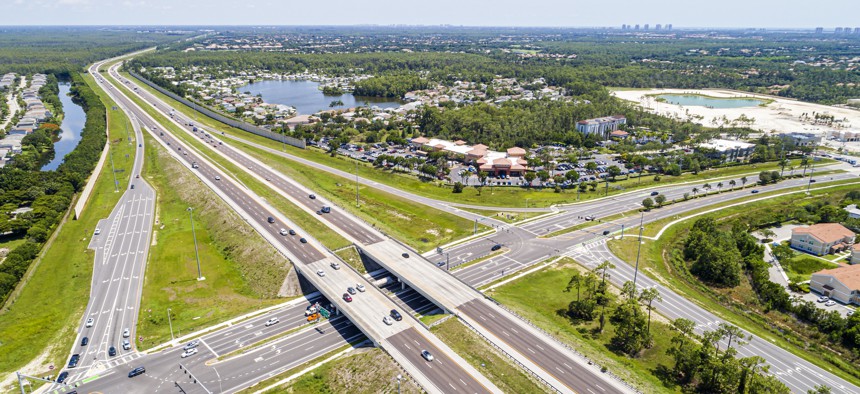Policy
State AGs, including Ashley Moody, at odds over proposed federal tailpipe emissions rules
Republican attorneys general say they are impractical and illegal. Democratic AGs applaud the proposals, but say they don’t go far enough.

Estero, Florida, I-75 highway Corkscrew Road aerial view. Photo by Jeffrey Greenberg/Universal Images Group via Getty Image
Red and blue states are once again at each other’s throats in a fight over federal anti-pollution laws.
But the clash – which now includes Florida Attorney General Ashley Moody – over a new Biden administration proposal to force automakers to start making electric cars and light trucks instead of gas-burning vehicles could be the biggest one yet.
The Environmental Protection Agency announced an aggressive plan in April to speed up the transition to electric vehicles. Federal officials said the new standards would indirectly require two-thirds of new vehicles sold in the U.S. in 2032 to be electric.
Half of new medium-duty vehicles, like delivery trucks, would also be electric by then. And the Biden administration is pushing for stricter pollution standards for heavier trucks too, albeit through a separate proposal.
Transportation is the biggest source of greenhouse gas pollution in the country, producing 28% of all such emissions. Cars and trucks generate more than half of that pollution. The EPA says that if its proposal goes into effect, it would eliminate four years’ worth of carbon dioxide emissions from the transportation sector by 2055.
The proposals also call for reductions in other types of air pollution, including nitrogen oxides and particulate matter. Both cause breathing problems in people, and nitrogen oxides contribute to acid rain.
Hundreds of organizations weighed in on the EPA’s new tailpipe emission proposals over a two-month comment period that ended July 5, but state and local leaders remain deeply divided on the administration’s approach.
A coalition of 25 Republican state attorneys general, including Moody, said in a comment letter that the proposal was both impractical and illegal.
“EPA is … putting automakers in the impossible position of trying to satisfy the proposed rule’s fast-and-furious production demands with a supply chain that is not ready for it, and at the cost of innovation that would have otherwise improved EV efforts in the short and long term,” they wrote.
The AGs also questioned the use of the Clean Air Act to justify the proposed regulations. The law specifies that the EPA may need to consider what technology is available and how much it costs.
“Clearly,” the Republican attorneys general warned, “Congress was concerned with not outpacing existing technology. In other words, though EPA can put a thumb on the scale to speed developments along, it cannot use its standard-setting power to will new fleets into existence that the market cannot deliver.”
They also argued that the agency would be exceeding the authority granted to it by Congress, pointing to a 2022 Supreme Court decision by conservative justices that curtailed the power of federal regulators.
The majority in West Virginia v. EPA adopted a new “major questions doctrine” that prevents federal agencies from acting on issues with significant economic impacts or political consequences unless Congress explicitly permits them to do so.
“There is a strong potential that reviewing courts will conclude that whether EPA can force electrification of the vast majority of the nation’s automobile industry is a major question that only Congress can answer, or else it must delegate in exceedingly clear terms,” the Republican lawyers wrote. “When the rule deliberately forces car dealers to take two-thirds of the most common types of vehicles off showroom floors to meet [EPA] ‘standards,’ the rule has morphed into something else.”
Meanwhile, 21 state Democratic attorneys general not only encouraged the EPA to adopt the rules it announced, but also asked the agency to make their proposal more stringent. Lawyers for the cities of Chicago, Los Angeles, New York and Oakland signed on, as well.
“Standards that effectively require the production and deployment of lower-emitting and zero-emission vehicles will promote longer-term, deeper emissions reductions critical to avoiding catastrophic impacts of climate change,” they wrote in a comment letter.
The EPA based its new standards on how much it would cost consumers and how feasible it would be to comply with the stricter limits.
But in both cases, the Democratic AGs argued, the EPA failed to consider how much change is already taking place, regardless of its new rule. Carmakers are building huge new factories to produce electric vehicles instead of gas-powered ones. States are promoting ways to enhance the electrical grid to accommodate vehicle charging.
Lawmakers are pushing states to buy electric vehicles for their own government fleets, while also offering incentives for customers to buy EVs. Plus, California is requiring 100% of new cars and smaller vehicles sold in the state to produce zero emissions by 2035, a standard that 11 other states are also adopting.
“The technologies necessary to reduce [greenhouse gases] and criteria pollutants from new motor vehicles already exist and are widely in use in the market today,” the Democratic officials argued. “The costs of these technologies are reasonable and declining, and the application of these technologies generally results in consumers saving money over the life of a new vehicle.
"Moreover, the societal benefits of more stringent standards significantly exceed the costs of those standards. EPA thus has every reason to adopt stronger emissions standards to satisfy its statutory mandate to reduce emissions of harmful air pollution.”
Many rural states and farm groups also commented on the proposals, raising concerns about how they would affect their livelihood. A South Dakota official, for example, said electric vehicles don’t have the range to be practical in rural areas.
The transition to EVswould also harm farmers, he warned, because they don’t depend on ethanol blends like gas-powered vehicles do. (Ethanol production accounts for 45% of total corn use in the country.)
“South Dakota is a rural state with a small population, wide open spaces and clean air,” wrote Hunter Roberts, the state’s secretary of agriculture and natural resources. “South Dakota is in full compliance or attainment with all federal criteria pollutants and the proposed emissions standards will not significantly improve our air quality.
“However, by essentially mandating EV use, they will limit the ability of our citizens to live and work in rural South Dakota.”
The transportation departments of Idaho, Montana, North Dakota, South Dakota and Wyoming warned that the EPA’s plan would jeopardize the federal Highway Trust Fund that pays the bulk of most major highway projects. The trust fund depends on federal motor fuel taxes, although Congress has repeatedly supplemented it with other sources for more than a decade.
“Proposed policies that would seriously weaken the flow of revenue into the [highway trust fund] place downward pressure on our ability to maintain and improve the transportation network. That, in turn, has adverse impacts on access to markets and the ability of people and businesses to access essential services, including schools, work, food and other basic shopping, health services and more,” they warned.
Automakers also balked at the planned pace of the emission reduction goals.
“Let me be clear: automotive electrification and carbon reduction is a goal automakers share with EPA and the administration,” wrote Mike Hartrick, the senior director for energy and the environment at the Alliance for Automotive Innovation, an auto industry group.
“The question isn’t can this be done, but how fast can it be done. In that context, EPA’s proposed greenhouse gas standards for 2027-2032 represents a significant movement of the country’s electrification goal posts—not by a little, but by a lot.”
“These proposed rules effectively require an additional 10-fold sales increase in a mere eight years. Put another way, they effectively place every state in the nation on a similar trajectory to California’s electrification targets, but at a fraction of the robust complementary policies put in place by that state over the past two decades. EPA is also proposing the most stringent criteria pollutant regulations ever, premised on largely the same levels of zero emission vehicles,” he explained.
Whether or not the industry can achieve the Biden administration’s goals depends on several factors beyond the control of manufacturers or their suppliers, Hartrick argued. Those include the availability of raw materials, customer enthusiasm and robust charging infrastructure in homes and in public places.
The Minnesota Pollution Control Agency, however, urged federal regulators to take a hard line on vehicle pollution. Even though vehicles have become cleaner because of previous EPA rules, those emission reductions have been offset by the fact that people have been driving more and have been driving heavier vehicles in recent years.
“Increased emissions stringency at the federal level is critical to continuing the trend of emission reductions in this sector,” wrote Frank Kohlasch, the assistant commissioner for air and climate policy for the Minnesota agency. “To address its regulatory obligations to reduce harmful climate-changing pollutants, EPA must lock in those commitments, ensure all manufacturers act, and push the manufacturers to go farther faster.”
The EPA proposal would help reduce pollution that disproportionately harms people of color, who are more likely to live near major roadways than white residents, he added. The federal rule would also complement Minnesota’s recent efforts to promote electric vehicle purchases.
“Minnesota has made significant efforts toward electrification; now we need EPA to adopt stringent vehicle emissions standards that will drive manufacturers to produce these vehicles at the scale needed to address climate change,” he wrote.
Daniel C. Vock is a senior reporter for Route Fifty, where a version of this story was first published. He is based in Washington, D.C.
NEXT STORY: Florida Gov. DeSantis says would-be migrant flights investigation is 'absurd'
